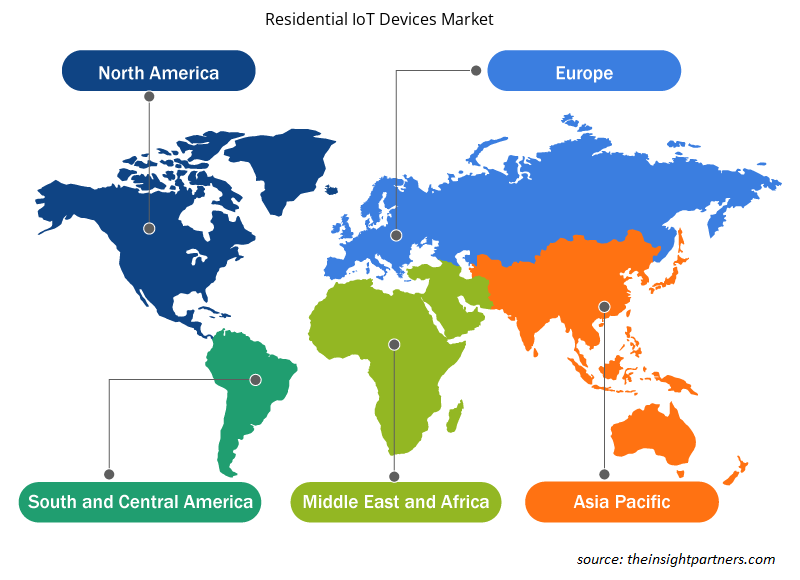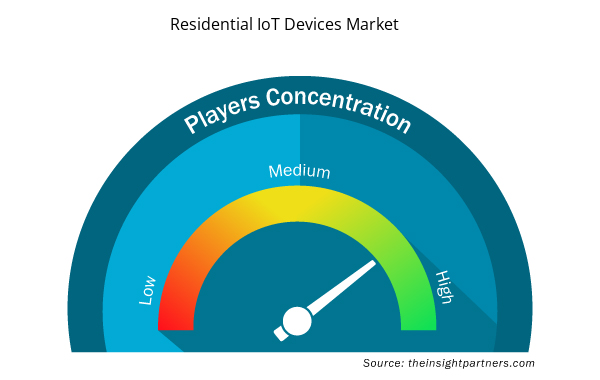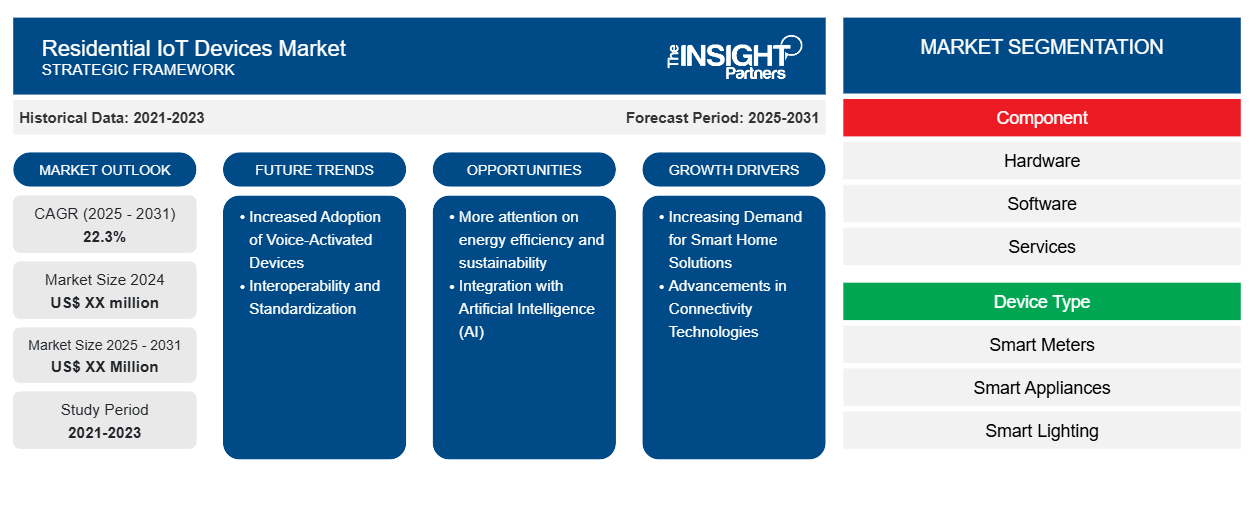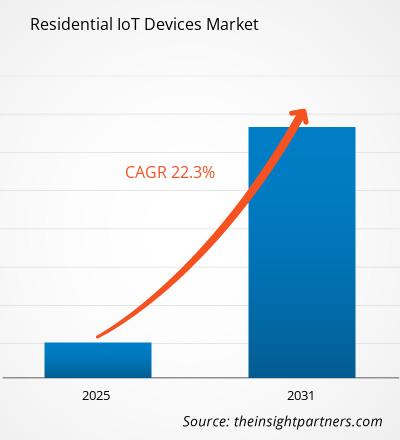Si prevede che il mercato dei dispositivi IoT residenziali registrerà un CAGR del 22,3% dal 2023 al 2031, con una dimensione di mercato in espansione da XX milioni di dollari nel 2023 a XX milioni di dollari entro il 2031.
Il report è segmentato per Componente [Hardware, Software, Servizi (Servizi professionali, Servizi gestiti)]; Tipo di dispositivo (Contatori intelligenti, Elettrodomestici intelligenti, Illuminazione intelligente, Gateway per la casa intelligente, Termostati intelligenti, Altri); Geografia (Nord America, Europa, Asia-Pacifico, Medio Oriente e Africa, Sud e Centro America).
L'analisi globale è ulteriormente suddivisa a livello regionale e nei principali paesi. Il report offre il valore in USD per l'analisi e i segmenti di cui sopra
Scopo del rapporto
Il report Residential IoT Devices Market di The Insight Partners mira a descrivere il panorama attuale e la crescita futura, i principali fattori trainanti, le sfide e le opportunità. Ciò fornirà spunti a vari stakeholder aziendali, come:
- Fornitori/produttori di tecnologia: per comprendere le dinamiche di mercato in evoluzione e conoscere le potenziali opportunità di crescita, consentendo loro di prendere decisioni strategiche informate.
- Investitori: condurre un'analisi completa delle tendenze in merito al tasso di crescita del mercato, alle proiezioni finanziarie del mercato e alle opportunità esistenti lungo la catena del valore.
- Enti di regolamentazione: regolamentano le politiche e le attività di controllo sul mercato allo scopo di ridurre al minimo gli abusi, preservare la fiducia degli investitori e sostenere l'integrità e la stabilità del mercato.
Segmentazione del mercato dei dispositivi IoT residenziali
Componente
- Hardware
- Software
- Servizi
Tipo di dispositivo
- Contatori intelligenti
- Elettrodomestici intelligenti
- Illuminazione intelligente
- Gateway per la casa intelligente
- Termostati intelligenti
- Altri
Personalizza questo report in base alle tue esigenze
Riceverai la personalizzazione gratuita di qualsiasi report, comprese parti di questo report, o analisi a livello nazionale, pacchetto dati Excel, oltre a usufruire di grandi offerte e sconti per start-up e università
- Scopri le principali tendenze di mercato in questo rapporto.Questo campione GRATUITO includerà analisi di dati che spaziano dalle tendenze di mercato alle stime e alle previsioni.
Driver di crescita del mercato dei dispositivi IoT residenziali
- Domanda crescente di soluzioni per la casa intelligente: il crescente interesse dei consumatori per le tecnologie per la casa intelligente è una delle principali forze trainanti del mercato dei dispositivi IoT residenziali. Comodità, sicurezza ed efficienza energetica in casa hanno alimentato la domanda dei consumatori di soluzioni per la casa intelligente. Termostati intelligenti, sistemi di illuminazione e telecamere di sicurezza stanno rapidamente diventando componenti integrati delle case moderne. Ciò è alimentato dalla domanda di una migliore gestione dell'ambiente domestico e dalla capacità di controllare da remoto i dispositivi tramite smartphone e assistenti vocali, che ha influenzato positivamente la crescente adozione dell'IoT nelle applicazioni residenziali.IoT devices market. Convenience, security, and energy efficiency at home have been fueling consumer demand for smart home solutions. Smart thermostats, lighting systems, and security cameras are fast becoming integrated components of modern homes. This is fueled by the demand for better home environment management and the capability to remotely control devices via smartphones and voice assistants, which has positively influenced the rising uptake of IoT in residential applications.
- Progressi nelle tecnologie di connettività: i progressi nelle tecnologie di connettività come Wi-Fi 6, Zigbee e Z-Wave stanno equipaggiando i dispositivi IoT residenziali. Tutte queste tecnologie consentono alle apparecchiature di funzionare in modo armonioso, garantendo una maggiore funzionalità e usabilità da parte degli utenti. Una migliore connettività integra più di un dispositivo nell'ambiente della casa intelligente e quindi consente una migliore gestione della casa per i consumatori. Affidabilità e ubiquità comportano l'aspettativa di una maggiore penetrazione dei dispositivi IoT.Wi-Fi 6, Zigbee, and Z-Wave are equipping residential IoT devices. All these technologies enable equipment to work in a harmonious manner, ensuring greater functionality and usability on behalf of users. Better connectivity integrates more than one device into the smart home environment, and thus makes better management of the house for consumers. Reliability and ubiquity come with an expectation of increased penetration by IoT devices.
Tendenze future del mercato dei dispositivi IoT residenzialiIoT Devices Market Future Trends
- Maggiore adozione di dispositivi ad attivazione vocale: è sempre più adottato, a causa della crescente tendenza verso assistenti virtuali come Amazon Alexa, Google Assistant e Apple Siri. Dispositivi come questi offrono un ulteriore vantaggio di praticità e usabilità perché consentono all'utente di manipolare i propri sistemi smart home tramite comandi vocali. La crescente domanda di dispositivi IoT ad attivazione vocale è dovuta anche al rapido sviluppo della tecnologia di riconoscimento vocale; presto, questo aumenterà man mano che le persone si abitueranno ai comandi vocali ogni giorno.Alexa, Google Assistant, and Apple Siri. Devices like these offer an added advantage of convenience and usability because they allow the user to manipulate their smart home systems through voice commands. The increased demand of voice-activated IoT devices is also due to rapid development in speech recognition technology; soon, this will increase as people become accustomed to voice commands every day.
- Interoperabilità e standardizzazione: con l'aumento del numero di dispositivi IoT in contesti residenziali, l'interoperabilità tra diversi dispositivi e piattaforme sta diventando una tendenza fondamentale. I consumatori vogliono che i dispositivi di diversi produttori funzionino insieme senza soluzione di continuità, consentendo un'esperienza di smart home coesa. Le aziende si stanno concentrando sullo sviluppo di dispositivi IoT che aderiscano a standard e protocolli comuni, come Zigbee, Z-Wave e Matter (in precedenza Project Connected Home over IP). La standardizzazione dei sistemi IoT consente ai dispositivi di vari produttori di comunicare tra loro, migliorando l'esperienza utente e promuovendo un'ulteriore adozione delle tecnologie IoT nelle case.IoT devices in residential settings grows, interoperability between different devices and platforms is becoming a key trend. Consumers want devices from different manufacturers to work together seamlessly, enabling a cohesive smart home experience. Companies are focusing on developing IoT devices that adhere to common standards and protocols, such as Zigbee, Z-Wave, and Matter (formerly Project Connected Home over IP). The standardization of IoT systems enables devices from various manufacturers to communicate with one another, enhancing user experience and driving further adoption of IoT technologies in homes.
Opportunità di mercato per i dispositivi IoT residenzialiIoT Devices Market Opportunities
- Maggiore attenzione all'efficienza energetica e alla sostenibilità: con i costi crescenti dell'energia e i crescenti problemi ambientali, la necessità di efficienza energetica e sostenibilità nelle aree residenziali è più alta che mai. I dispositivi IoT come i contatori intelligenti e i sistemi di gestione dell'energia consentono ai clienti di monitorare e quindi ottimizzare il loro consumo energetico. I dispositivi offrono dati e approfondimenti in tempo reale all'utente in modo che possa prendere decisioni migliori in riferimento ai livelli di consumo energetico correnti, risparmiando così denaro e riducendo l'impronta di carbonio. Questa tecnologia ha quindi scatenato una domanda di soluzioni IoT domestiche che supportano una vita sostenibile.IoT devices such as smart meters and energy management systems enable customers to track and then optimize their energy consumption. The devices offer real-time data and insights to the user so that they can make better decisions in reference to current energy consumption levels, thereby saving them money while reducing carbon footprint. This technology has therefore sparked a demand for home IoT solutions that support sustainable living.
- Integrazione con l'intelligenza artificiale (IA): esiste un'enorme possibilità di innovazione e miglioramento funzionale con l'IA nei dispositivi IoT residenziali. Attraverso l'IA, i dispositivi possono apprendere le preferenze dell'utente, automatizzare le routine e fornire raccomandazioni personalizzate per un'esperienza utente migliorata. In uno scenario in cui le soluzioni per la casa intelligenti e intuitive sono richieste dai consumatori, le aziende possono distinguersi dalla concorrenza con offerte IoT basate sull'IA.IoT devices. Through AI, devices can learn preferences of the user, automate routines, and provide personalized recommendations for enhanced user experience. In a scenario where smart and intuitive home solutions are in demand by consumers, companies can separate themselves from competition with AI-based IoT offerings.
Approfondimenti regionali sul mercato dei dispositivi IoT residenzialiIoT Devices Market Regional Insights
Le tendenze regionali e i fattori che influenzano il mercato dei dispositivi IoT residenziali durante il periodo di previsione sono stati ampiamente spiegati dagli analisti di Insight Partners. Questa sezione discute anche i segmenti e la geografia del mercato dei dispositivi IoT residenziali in Nord America, Europa, Asia Pacifico, Medio Oriente e Africa e America meridionale e centrale.IoT Devices Market throughout the forecast period have been thoroughly explained by the analysts at Insight Partners. This section also discusses Residential IoT Devices Market segments and geography across North America, Europe, Asia Pacific, Middle East and Africa, and South and Central America.

- Ottieni i dati specifici regionali per il mercato dei dispositivi IoT residenziali
Ambito del rapporto di mercato sui dispositivi IoT residenziali
| Attributo del report | Dettagli |
|---|---|
| Dimensioni del mercato nel 2023 | XX milioni di dollari USA |
| Dimensioni del mercato entro il 2031 | XX milioni di dollari USA |
| CAGR globale (2023-2031) | 22,3% |
| Dati storici | 2021-2022 |
| Periodo di previsione | 2024-2031 |
| Segmenti coperti | Per componente
|
| Regioni e Paesi coperti | America del Nord
|
| Leader di mercato e profili aziendali chiave |
|
Densità dei player del mercato dei dispositivi IoT residenziali: comprendere il suo impatto sulle dinamiche aziendali
Il mercato dei dispositivi IoT residenziali sta crescendo rapidamente, spinto dalla crescente domanda degli utenti finali dovuta a fattori quali l'evoluzione delle preferenze dei consumatori, i progressi tecnologici e una maggiore consapevolezza dei vantaggi del prodotto. Con l'aumento della domanda, le aziende stanno ampliando le loro offerte, innovando per soddisfare le esigenze dei consumatori e capitalizzando sulle tendenze emergenti, il che alimenta ulteriormente la crescita del mercato.
La densità degli operatori di mercato si riferisce alla distribuzione di aziende o società che operano in un particolare mercato o settore. Indica quanti concorrenti (operatori di mercato) sono presenti in un dato spazio di mercato in relazione alle sue dimensioni o al valore di mercato totale.
Le principali aziende che operano nel mercato dei dispositivi IoT residenziali sono:
- Amazon.com, Inc.
- Bosch.IO GmbH (Robert Bosch GmbH)
- ecoape
- Google, LLC
- Honeywell International Inc.
Disclaimer : le aziende elencate sopra non sono classificate secondo un ordine particolare.

- Ottieni una panoramica dei principali attori del mercato dei dispositivi IoT residenziali
Punti di forza chiave
- Copertura completa: il rapporto copre in modo completo l'analisi di prodotti, servizi, tipologie e utenti finali del mercato dei dispositivi IoT residenziali, fornendo una panoramica olistica.
- Analisi degli esperti: il rapporto è compilato sulla base della conoscenza approfondita di esperti e analisti del settore.
- Informazioni aggiornate: il rapporto garantisce la pertinenza aziendale grazie alla copertura di informazioni recenti e tendenze nei dati.
- Opzioni di personalizzazione: questo report può essere personalizzato per soddisfare le esigenze specifiche del cliente e adattarsi in modo appropriato alle strategie aziendali.
Il rapporto di ricerca sul mercato dei dispositivi IoT residenziali può, quindi, aiutare a guidare il percorso di decodifica e comprensione dello scenario del settore e delle prospettive di crescita. Sebbene possano esserci alcune preoccupazioni valide, i vantaggi complessivi di questo rapporto tendono a superare gli svantaggi.
- Analisi storica (2 anni), anno base, previsione (7 anni) con CAGR
- Analisi PEST e SWOT
- Valore/volume delle dimensioni del mercato - Globale, regionale, nazionale
- Industria e panorama competitivo
- Set di dati Excel



Report Coverage
Revenue forecast, Company Analysis, Industry landscape, Growth factors, and Trends

Segment Covered
This text is related
to segments covered.

Regional Scope
North America, Europe, Asia Pacific, Middle East & Africa, South & Central America

Country Scope
This text is related
to country scope.
Domande frequenti
Some of the customization options available based on the request are an additional 3-5 company profiles and country-specific analysis of 3-5 countries of your choice. Customizations are to be requested/discussed before making final order confirmation# as our team would review the same and check the feasibility
The report can be delivered in PDF/PPT format; we can also share excel dataset based on the request
Increased Adoption of Voice-Activated Devices is anticipated to play a significant role in the global Residential IoT Devices Market in the coming years
Increasing Demand for Smart Home Solutions and Advancements in Connectivity Technologies are the major factors driving the Residential IoT Devices Market
The Residential IoT Devices Market is estimated to witness a CAGR of 22.3% from 2023 to 2031
Trends and growth analysis reports related to Electronics and Semiconductor : READ MORE..
1.Amazon.com, Inc.
2.Bosch.IO GmbH (Robert Bosch GmbH)
3.ecobee
4.Google, LLC
5.Honeywell International Inc.
6.LG Electronics
7.Qualcomm Technologies, Inc.
8.Radio Thermostat Company of America
9.Samsung
10.Signify Holding
The Insight Partners performs research in 4 major stages: Data Collection & Secondary Research, Primary Research, Data Analysis and Data Triangulation & Final Review.
- Data Collection and Secondary Research:
As a market research and consulting firm operating from a decade, we have published and advised several client across the globe. First step for any study will start with an assessment of currently available data and insights from existing reports. Further, historical and current market information is collected from Investor Presentations, Annual Reports, SEC Filings, etc., and other information related to company’s performance and market positioning are gathered from Paid Databases (Factiva, Hoovers, and Reuters) and various other publications available in public domain.
Several associations trade associates, technical forums, institutes, societies and organization are accessed to gain technical as well as market related insights through their publications such as research papers, blogs and press releases related to the studies are referred to get cues about the market. Further, white papers, journals, magazines, and other news articles published in last 3 years are scrutinized and analyzed to understand the current market trends.
- Primary Research:
The primarily interview analysis comprise of data obtained from industry participants interview and answers to survey questions gathered by in-house primary team.
For primary research, interviews are conducted with industry experts/CEOs/Marketing Managers/VPs/Subject Matter Experts from both demand and supply side to get a 360-degree view of the market. The primary team conducts several interviews based on the complexity of the markets to understand the various market trends and dynamics which makes research more credible and precise.
A typical research interview fulfils the following functions:
- Provides first-hand information on the market size, market trends, growth trends, competitive landscape, and outlook
- Validates and strengthens in-house secondary research findings
- Develops the analysis team’s expertise and market understanding
Primary research involves email interactions and telephone interviews for each market, category, segment, and sub-segment across geographies. The participants who typically take part in such a process include, but are not limited to:
- Industry participants: VPs, business development managers, market intelligence managers and national sales managers
- Outside experts: Valuation experts, research analysts and key opinion leaders specializing in the electronics and semiconductor industry.
Below is the breakup of our primary respondents by company, designation, and region:

Once we receive the confirmation from primary research sources or primary respondents, we finalize the base year market estimation and forecast the data as per the macroeconomic and microeconomic factors assessed during data collection.
- Data Analysis:
Once data is validated through both secondary as well as primary respondents, we finalize the market estimations by hypothesis formulation and factor analysis at regional and country level.
- Macro-Economic Factor Analysis:
We analyse macroeconomic indicators such the gross domestic product (GDP), increase in the demand for goods and services across industries, technological advancement, regional economic growth, governmental policies, the influence of COVID-19, PEST analysis, and other aspects. This analysis aids in setting benchmarks for various nations/regions and approximating market splits. Additionally, the general trend of the aforementioned components aid in determining the market's development possibilities.
- Country Level Data:
Various factors that are especially aligned to the country are taken into account to determine the market size for a certain area and country, including the presence of vendors, such as headquarters and offices, the country's GDP, demand patterns, and industry growth. To comprehend the market dynamics for the nation, a number of growth variables, inhibitors, application areas, and current market trends are researched. The aforementioned elements aid in determining the country's overall market's growth potential.
- Company Profile:
The “Table of Contents” is formulated by listing and analyzing more than 25 - 30 companies operating in the market ecosystem across geographies. However, we profile only 10 companies as a standard practice in our syndicate reports. These 10 companies comprise leading, emerging, and regional players. Nonetheless, our analysis is not restricted to the 10 listed companies, we also analyze other companies present in the market to develop a holistic view and understand the prevailing trends. The “Company Profiles” section in the report covers key facts, business description, products & services, financial information, SWOT analysis, and key developments. The financial information presented is extracted from the annual reports and official documents of the publicly listed companies. Upon collecting the information for the sections of respective companies, we verify them via various primary sources and then compile the data in respective company profiles. The company level information helps us in deriving the base number as well as in forecasting the market size.
- Developing Base Number:
Aggregation of sales statistics (2020-2022) and macro-economic factor, and other secondary and primary research insights are utilized to arrive at base number and related market shares for 2022. The data gaps are identified in this step and relevant market data is analyzed, collected from paid primary interviews or databases. On finalizing the base year market size, forecasts are developed on the basis of macro-economic, industry and market growth factors and company level analysis.
- Data Triangulation and Final Review:
The market findings and base year market size calculations are validated from supply as well as demand side. Demand side validations are based on macro-economic factor analysis and benchmarks for respective regions and countries. In case of supply side validations, revenues of major companies are estimated (in case not available) based on industry benchmark, approximate number of employees, product portfolio, and primary interviews revenues are gathered. Further revenue from target product/service segment is assessed to avoid overshooting of market statistics. In case of heavy deviations between supply and demand side values, all thes steps are repeated to achieve synchronization.
We follow an iterative model, wherein we share our research findings with Subject Matter Experts (SME’s) and Key Opinion Leaders (KOLs) until consensus view of the market is not formulated – this model negates any drastic deviation in the opinions of experts. Only validated and universally acceptable research findings are quoted in our reports.
We have important check points that we use to validate our research findings – which we call – data triangulation, where we validate the information, we generate from secondary sources with primary interviews and then we re-validate with our internal data bases and Subject matter experts. This comprehensive model enables us to deliver high quality, reliable data in shortest possible time.


 Ottieni un campione gratuito per questo repot
Ottieni un campione gratuito per questo repot